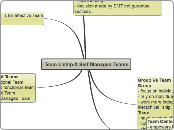Team L'ship & Self Managed Teams
SMT
Benefits
- greater improvement in quality, speed, process and innovation.
- sense of belonging and ownership in work
- greater employee motivation
- greater employee participation.
Challenges
- managers may resist or undermine the transition of power
- team member may experience anxiety
- social loafing
- decision made by SMT not gurantee success.
Group Vs Team
Group
- focus on individual performance and goals
- rely on individual abilities
- work more independen- have a very hierachical l'ship.
Team
- have a sense of shared mission
- collective responsibilty
- sharing info, insights, perspctive
Leadership Skills for effective Team Meetings.
Planning Meetings
- Obj
- Selecting participants and making assgn
- the agenda
- leadership
Conducting Meetings
- idenfying obj
- covering agenda items
- summarizing and reviewing assgn
Handling Problem Members
- silent
- talkers
- wanderers
- arguers
Type of Teams
- Functional Team
- Cross functional Team
- Virtual Team
- Self Managed Team
Functional Teams
- employees belongings to same functional department. eg R&D, Human resource, information system.
- generally more hierachical
Cross Functional Team
- made up from diff functional department and brought together to perform tasks to create new job.
Virtual Team
- one whose member are geographically distributed, required them to work together thru electronic device.
- New advance technology are providing means for teamwork that is dispersed.
Self Managed Team (SMT)
- relatively autonomous teams whose member hodl their own resposibilities for a set of goals assigned.
Leader-Centered Decision Making Model vs Team-Centered Decision Making Model
Team Leader Practices that Foster Creativity
Matching ppl with right assgn.
Giving team member greater autonomy to do the job
Protect against "creativity blockers"
Ensuring the avaibility of adequate time, money, and other resources.
Leader Centered
- leader exercises his or her power to initiate, direct, drive, instruct and control team members
To be successful, leader should:
- focus on task
- seek opinions
- get agreement
Team Work
- understanding and commitment to groups goals on the part of all team.
Challenges:
- need of effective comm
- clarify team structure
- effective leadership
- establish unify goal
Adv of Teamwork
- synergy
- avoidance of major concern
- faster better decision
- innovation
Disadv of Teamwork
- pressure to conform to group standards
- social loafing
- group thinking
- high level pressure and stress
Social Loafing
- phenomenon of people making less effort to achieve a goal when they work in a group than when they work alone.
Group Thinking
- members tend to agree the decision for taking majority viewpoint
